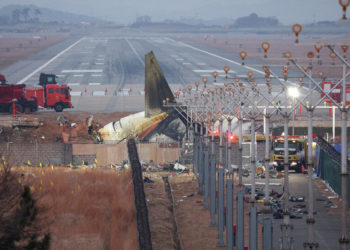Nails. Thousands of completely normal nails, each one driven into a wooden board covered with linen. Some straight, some slanted, but none hammered in all the way. Sewing machines, chairs, record players and grand pianos have also borne the brunt of those little shafts of steel.
Artist Günther Uecker, who has died on June 10 at the age of 95, became famous in Germany and beyond through his nail reliefs.
Hardly any other artist has equally dedicated his work to the craft of simple physical labor. Even during the last years of his life, he was still hammering nails into backdrops and objects with force and precision.
Günther Uecker created reliefs that he termed “nail fields.” The works achieve their full effect in the play of light and shadow.
A life of war and peace
Born in the of town of Wendorf near Schwerin in northeastern Germany on March 13, 1930, Günther Uecker found himself boarding up doors and windows of his family house at age 15 in an effort to protect his mother and sister from the Russian army at war’s end. It was the beginning of a life-long preoccupation with hammers and nails.
Post-World War II, he studied pictorial arts from 1949 until 1953 in Wismar, then in . In 1955 he fled to West Berlin and eventually found himself at the Art Academy in Düsseldorf, studying under Professor Otto Pankok from 1955-57.
During his studies he encountered the artists and Otto Piene and joined their artists’ conglomerate named ZERO in 1961. Together they represented a “zero hour” of art untouched by the horrors of the Second World War, marking a new beginning in art history.
Timeless art, nailed and painted
The avant-garde artists’ group made waves far beyond Germany and their time. ZERO’s ideas have undergone a renaissance in the new millennium, with ZERO retrospectives staged regularly worldwide since 2004.
Back in 1966, no one could have anticipated the group’s future popularity. It dissolved soon afterwards, and the artists went their separate ways.
Meanwhile, Günther Uecker’s abstract art has been shown in over 60 countries and frequently been considered pioneering. In 2012 he became the first Western artist to be exhibited in the Iranian capital Tehran since the 1979 revolution. In 2007 came an exhibition in Beijing originally scheduled for 1994. On invitation from the Chinese government, Uecker had prepared the conceptual artwork “Letter to Beijing.”
In this work, the was reproduced on 19 large, freely-arranged screens, but the words were partially rendered unrecognizable by black paint.
However, on short notice, the Chinese culture ministry cancelled the show in 1994, explaining that the people were not yet ready for his art. Uecker was permitted to exhibit in China 18 years later.
Humanist artistic ideals
“Letter to Beijing” isn’t the only work in which Uecker addressed human rights violations. In “Verletzungsworte” (Words That Hurt), on display in various cities of the world since 1993, 60 words like “hitting,” “despising” and “gassing” that describe physical and psychological abuse are translated into local languages and painstakingly added by Uecker to the artwork.
Günther Uecker’s art is understood — and esteemed — worldwide and in the most diverse cultures. Asked what makes it so universal, Uecker once volunteered his own explanation: “I’m often told that the humane character recognizable in my work stirs peoples’ feelings.”
This article was originally written in German and is an updated version of a profile of the artist for his 90th birthday.
The post Avant-garde nail art creator, Günther Uecker, dies aged 95 appeared first on Deutsche Welle.




